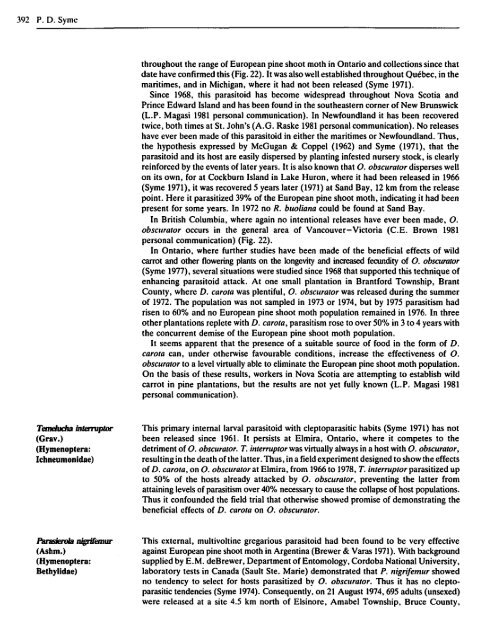pdf, 57.71Mb - Entomological Society of Canada
pdf, 57.71Mb - Entomological Society of Canada
pdf, 57.71Mb - Entomological Society of Canada
Create successful ePaper yourself
Turn your PDF publications into a flip-book with our unique Google optimized e-Paper software.
392 P. D. Syme<br />
Temelucha inlemlptor<br />
(Grav.)<br />
(Hymenoptera:<br />
Ichneumonidae)<br />
ParageroIa nigrifemur<br />
(Ashm.)<br />
(Hymenoptera:<br />
Bethylldae)<br />
throughout the range <strong>of</strong> European pine shoot moth in Ontario and collections since that<br />
date have confirmed this (Fig. 22). It was also well established throughout Quebec, in the<br />
maritimes, and in Michigan, where it had not been released (Syme 1971).<br />
Since 1968, this parasitoid has become widespread throughout Nova Scotia and<br />
Prince Edward Island and has been found in the southeastern corner <strong>of</strong> New Brunswick<br />
(L.P. Magasi 1981 personal communication). In Newfoundland it has been recovered<br />
twice, both times at St. John's (A.G. Raske 1981 personal communication). No releases<br />
have ever been made <strong>of</strong> this parasitoid in either the maritimes or Newfoundland. Thus,<br />
the hypothesis expressed by McGugan & Coppel (1962) and Syme (1971), that the<br />
parasitoid and its host are easily dispersed by planting infested nursery stock, is clearly<br />
reinforced by the events <strong>of</strong> later years. It is also known that O. obscurator disperses well<br />
on its own, for at Cockburn Island in Lake Huron, where it had been released in 1966<br />
(Syme 1971), it was recovered 5 years later (1971) at Sand Bay, 12 km from the release<br />
point. Here it parasitized 39% <strong>of</strong> the European pine shoot moth, indicating it had been<br />
present for some years. In 1972 no R. buo[iana could be found at Sand Bay.<br />
In British Columbia, where again no intentional releases have ever been made, O.<br />
obscllrator occurs in the general area <strong>of</strong> Vancouver-Victoria (C.E. Brown 1981<br />
personal communication) (Fig. 22).<br />
In Ontario, where further studies have been made <strong>of</strong> the beneficial effects <strong>of</strong> wild<br />
carrot and other flowering plants on the longevity and increased fecundity <strong>of</strong> O. obsauator<br />
(Syme 1977), several situations were studied since 1968 that supported this technique <strong>of</strong><br />
enhancing parasitoid attack. At one small plantation in Brantford Township, Brant<br />
County, where D. carota was plentiful, O. obscllralor was released during the summer<br />
<strong>of</strong> 1972. The population was not sampled in 1973 or 1974, but by 1975 parasitism had<br />
risen to 60% and no European pine shoot moth population remained in 1976. In three<br />
other plantations replete with D. carota, parasitism rose to over 50% in 3 to 4 years with<br />
the concurrent demise <strong>of</strong> the European pine shoot moth population.<br />
It seems apparent that the presence <strong>of</strong> a suitable source <strong>of</strong> food in the form <strong>of</strong> D.<br />
carota can, under otherwise favourable conditions, increase the effectiveness <strong>of</strong> O.<br />
obscllrator to a level virtually able to eliminate the European pine shoot moth population.<br />
On the basis <strong>of</strong> these results, workers in Nova Scotia are attempting to establish wild<br />
carrot in pine plantations, but the results are not yet fully known (L.P. Magasi 1981<br />
personal communication).<br />
This primary internal larval parasitoid with cleptoparasitic habits (Syme 1971) has not<br />
been released since 1961. It persists at Elmira, Ontario, where it competes to the<br />
detriment <strong>of</strong> O. obscllralor. T. interrllptor was virtually always in a host with O. obscllrator,<br />
resulting in the death <strong>of</strong> the latter. Thus, in a field experiment designed to show the effects<br />
<strong>of</strong> D. carola, on O. obscllralor at Elmira, from 1966 to 1978, T. interrllptor parasitized up<br />
to 50% <strong>of</strong> the hosts already attacked by O. obscuralor, preventing the latter from<br />
attaining levels <strong>of</strong> parasitism over 40% necessary to cause the collapse <strong>of</strong> host populations.<br />
Thus it confounded the field trial that otherwise showed promise <strong>of</strong> demonstrating the<br />
beneficial effects <strong>of</strong> D. carota on O. obscurator.<br />
This external, multivoltine gregarious parasitoid had been found to be very effective<br />
against European pine shoot moth in Argentina (Brewer & Varas 1971). With background<br />
supplied by E.M. deBrewer, Department <strong>of</strong> Entomology, Cordoba National University,<br />
laboratory tests in <strong>Canada</strong> (Sault Ste. Marie) demonstrated that P. nigrifemur showed<br />
no tendency to select for hosts parasitized by O. obscllralor. Thus it has no cleptoparasitic<br />
tendencies (Syme 1974). Consequently, on 21 August 1974,695 adults (unsexed)<br />
were released at a site 4.5 km north <strong>of</strong> Elsinore, Amabel Township, Bruce County,
















